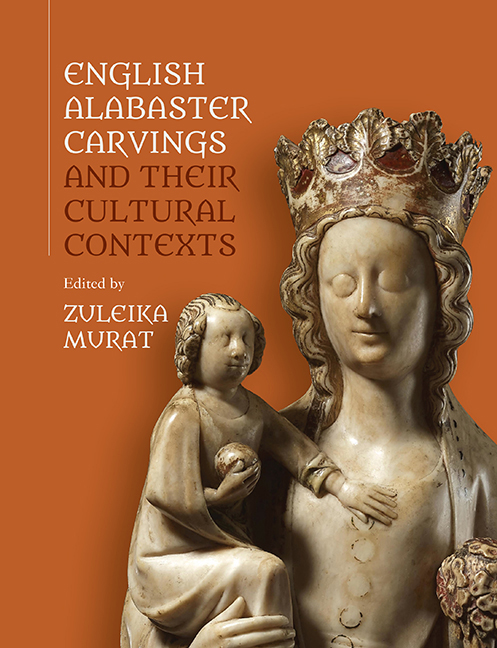Book contents
- Frontmatter
- CONTENTS
- List of Illustrations
- Acknowledgements
- List of Contributors
- Introduction
- 1 ‘Burton-Upon-Trent, Not Nottingham.’ the Evolving Study Of Medieval English Alabaster Sculpture
- 2 Stone to Ensure Victory and to Generate Friendships. On The Meaning of Alabaster
- 3 Contextualising English Alabasters in the Material Culture of the Medieval Mediterranean
- 4 English Alabaster Images As Recipients of Music in the Long Fifteenth Century: English Sacred Traditions in a European Perspective
- 5 Contextualising Alabasters in Their Immersive Environment. The ‘Ancona D'Allabastro Di Diverse Figure’ of the Novalesa Abbey: Meaning and Function
- 6 Alabaster Carvings in Late-Medieval Lincolnshire
- 7 ‘Tabernacles, Howsynges and Other Things’. Three Alabasters From the Burrell Collection in Context
- 8 Conservation Study of Three Alabaster Carvings From the Burrell Collection, Glasgow Museums
- 9 ‘Smooth as Monumental Alabaster’. the Alabaster Tomb Industry in England 1550–1660
- 10 Merchants’ Tombs in Alabaster
- 11 Exploring Alice: the Theological, Socio-Historical, and Anatomical Context of the De La Pole Cadaver Sculpture
- Bibliography
- Index
- Already Published
2 - Stone to Ensure Victory and to Generate Friendships. On The Meaning of Alabaster
Published online by Cambridge University Press: 14 September 2019
- Frontmatter
- CONTENTS
- List of Illustrations
- Acknowledgements
- List of Contributors
- Introduction
- 1 ‘Burton-Upon-Trent, Not Nottingham.’ the Evolving Study Of Medieval English Alabaster Sculpture
- 2 Stone to Ensure Victory and to Generate Friendships. On The Meaning of Alabaster
- 3 Contextualising English Alabasters in the Material Culture of the Medieval Mediterranean
- 4 English Alabaster Images As Recipients of Music in the Long Fifteenth Century: English Sacred Traditions in a European Perspective
- 5 Contextualising Alabasters in Their Immersive Environment. The ‘Ancona D'Allabastro Di Diverse Figure’ of the Novalesa Abbey: Meaning and Function
- 6 Alabaster Carvings in Late-Medieval Lincolnshire
- 7 ‘Tabernacles, Howsynges and Other Things’. Three Alabasters From the Burrell Collection in Context
- 8 Conservation Study of Three Alabaster Carvings From the Burrell Collection, Glasgow Museums
- 9 ‘Smooth as Monumental Alabaster’. the Alabaster Tomb Industry in England 1550–1660
- 10 Merchants’ Tombs in Alabaster
- 11 Exploring Alice: the Theological, Socio-Historical, and Anatomical Context of the De La Pole Cadaver Sculpture
- Bibliography
- Index
- Already Published
Summary
Because of its extensive usage from the fourteenth century onwards, alabaster plays a considerable role not only in English art but also more broadly, in culture. While the cross-epochal tradition of quarrying and carving the material has been the subject of many studies, the meaning of alabaster and the issue of its place in the overall hierarchy of artistic materials has rarely been addressed in any depth in the past. This corresponds with a general negligence on the part of art history scholars to study the material aspects of an artwork, an approach that only began to be called into question in the 1990s.
Thus, with the self-imposed aim of filling in this gap in the research, this chapter outlines the meanings ascribed to alabaster through the ages as a result of its employment in various human activities, not solely art. To this end a variety of sources will be consulted in order to reconstruct what might be called the cultural image of alabaster, with all its continuities and discontinuities. Furthermore, these notions surrounding alabaster will be confronted with an analysis of selected art works in order to demonstrate how a knowledge of the broad cultural context in which one material functions relates to a particular art work. Third, in the final section of the paper, the meanings attached to alabaster from antiquity to Early Modern times will be compared to its perception and semanticization in the early twentieth century, after the ‘material revolution’, which brought a total reorganization of the hierarchies of artistic materials and meanings ascribed to them.
…BUT ONE DEGREE BENEATH MARBLE
One rudimentary issue encountered when examining historical sources relating to artworks is that of interpretation of the names for the materials that are used in them. In order to draw any reliable conclusions, the historical and local variability of the nomenclature, as well as the varying competencies and aims of the authors of the relevant texts, have to be taken into consideration. Owing to its physical properties the most common issue in the case of alabaster is references to it as marble, and vice versa.
- Type
- Chapter
- Information
- English Alabaster Carvings and their Cultural Contexts , pp. 51 - 70Publisher: Boydell & BrewerPrint publication year: 2019



